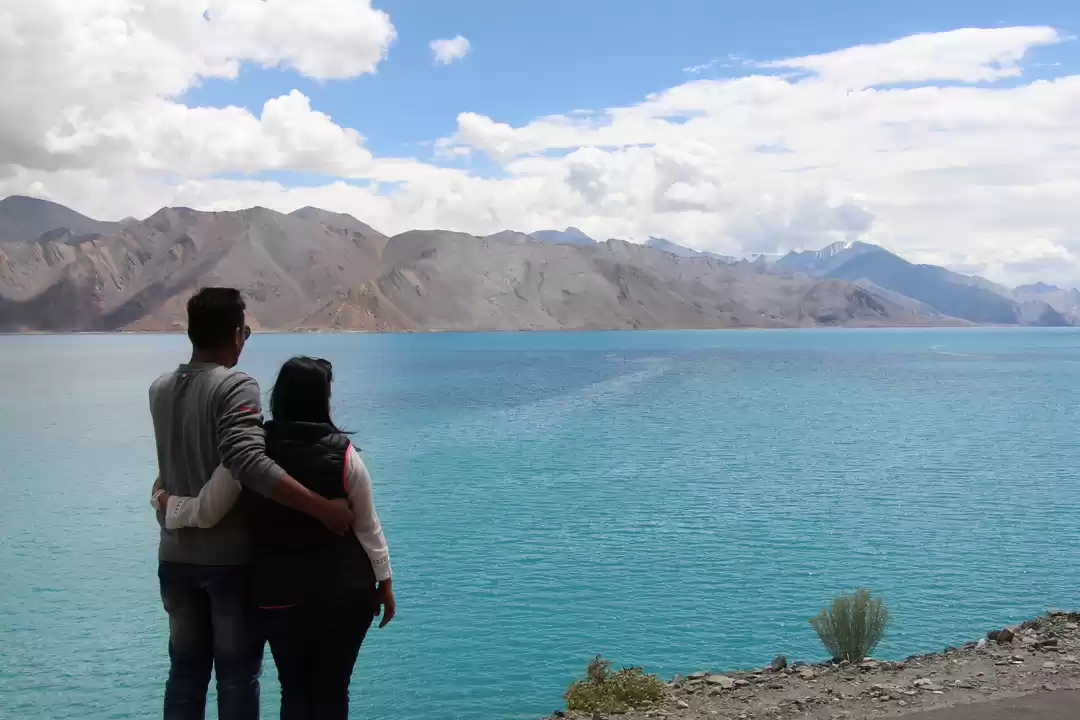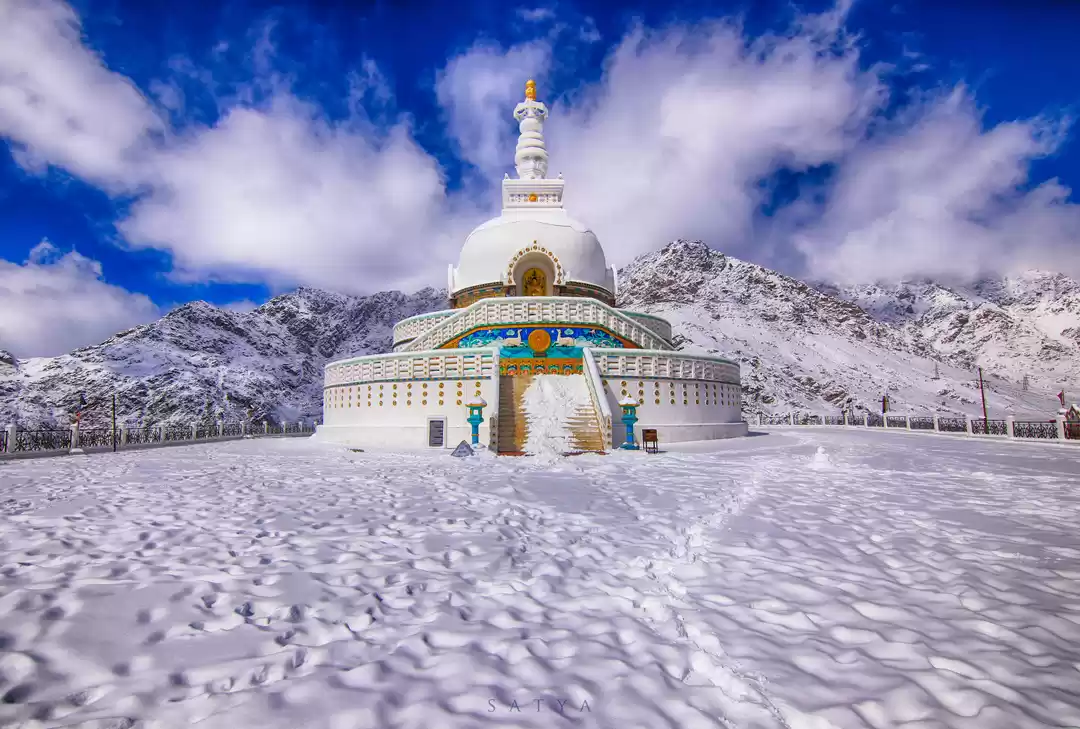Snow-clad mountains. Clear blue skies. Crystal clear lakes. Picture-perfect monasteries. Mouth-watering food. Warm, friendly people. Jullay!

It’s been a while since, hesitantly, I booked the trip, that I had to take before I hit the third decade of my life, with a women-only travel group; except my roomie-for-the-trip, my childhood friend, I didn’t have a clue about the others: would they be friendly or grumpy or snooty? It’s been a while since I headed to the Delhi airport in the wee hours of a Wednesday. It’s been a while since I boarded the flight to the upper reaches of the Himalayas. It’s been a while since the day, with sleep-laden eyes, I spotted barren, brown mountains on my right and icy, white peaks on my left.
Six am. Touch-down at Leh airbase. Thus began the eight-day vacation to the Land of High Passes.

Six-fifteen. Baggage collection: check. The first difference I felt was the chill. Coming from 45+ degrees and being thrown straight into a 4 was a pleasant surprise. Out came the socks and jacket and muffler. Little did I know there was another surprise in store. In all the commotion I forgot where I was. I was standing at an altitude of 3,500 metres. I had heard of the most precious thing here in Ladakh.
O-X-Y-G-E-N.
Now I felt it. It is rare and every gulp should be cherished.
I met the rest of the gang, dressed in pink as per the mandate of the tour organizers. A handful of women from Delhi, Mumbai, Bangalore, and Hyderabad. A quick round of introductions and we headed straight to our cars. Immediately our group of four was formed, and we stuck to each other and braved snowstorms, duststorms, hailstorms till the very end.
We headed straight to our hotel, Spic n Span. Hot puris and chai were a warm relief. We were then pushed off to our rooms for a quick nap. To acclimatize ourselves. But my roomie and I had other plans. We snuck out soon after to explore Leh Bazaar, which was then (2015) under rehabilitation post 2010 flash floods. Of course we were chided by our tour guide Dorjay for not having taken enough rest, and of course we diligently nodded with muffled chuckles. In the evening we headed to the nearby Shanti Stupa and Leh Palace. Located on a hilltop in Chanspa district is the Shanti Stupa. Built in 1991 by Japanese and Ladakhi Buddhist monks, it holds relics of the Buddha at its base, enshrined by His Holiness the Fourteenth Dalai Lama. After the mesmerizing panoramic view – Stok village on the right, white peaks behind, Khardung La on the left, Leh Palace ahead – we started for the ruins of the palace. Bathed in golden of the twilight, it has stood the test of time. A former royal palace built by King Sengge Namgyal in the seventeenth century, all its nine storeys are open for tourists. We clambered on for an even better view of the valley. Across the palace lay the beautiful Castle Tse Mo, accessible only by a zig-zagged path. Alas time did not permit a visit so the shutterbugs took as many photographs as the heart desired.


‘Where do we find Moonland on Earth?’
‘Duh, look behind!’
The moonland-scape of Lamayuru and its eleventh-century monastery are sights to beckon. The light brown peaks give way to a bright speck on a faraway hill. Lamayuru or Yuru Monastery (‘Eternal Monastery’) is a Tibetan Buddhist monastery in Leh district, on the Srinagar-Leh highway. Rinchen Zangpo (958–1055), translator of Sanskrit Buddhist texts into Tibetan, architect, and monk, was commissioned by the king of Ladakh to build 108 gompas in Ladakh, Spiti Valley, and the surrounding regions.

Lamayuru is one of the largest and oldest gompas in Ladakh dating from his time. About 150 monks stay here, on the meditation hill, arguably the best place to get the most stunning view of the picturesque village. Prayer flags fluttered and prayer wheels turned as we made our way uphill to the prayer hall. We were humbled to see the simple lives the monks led. The main chamber had numerous lit candles and ferocious masks – the monastery is host to two annual masked dance festivals. After the visit we strode our way through serpentine village roads, greeted by school kids.


Next morning we were in for a long drive: from Leh to Nubra valley via the highest motorable pass in the world, Khardung La. Motion sickness kicked in soon after we commenced journey. The rugged roads added to it. In the daze I noticed specks of dust hitting the windshield.
‘Lobsang, where is the dust coming from?’
‘It’s snow, Madam!’
Snow? SNOW? My very first snowfall! How I wished for it from the beginning. Sickness disappeared instantly and I sat upright and caught my very first snowflake. Just how it’s drawn; so pretty, so fragile. Within minutes it turned white outside! And in a few hours, driving through the white canvas, we reached Khardung La. We made a quick stop for photographs in front of the Indian Army board announcing ‘Khardungla Top, 18380 ft, World’s Highest Motorable Road’. The Maggie Point was closed as consumption of Maggie was then banned.

We proceeded through unpaved roads until we stumbled upon green pastures and grazing yaks. Enter Nubra valley where the Shyok river (tributary of the Indus which flows into Pakistan) meets the Nubra/Siachan river to form a large valley that separates the Ladakh and Karakoram ranges.
Our ‘deluxe’ camp, Desert Himalaya, was nestled in the green valley and had donkeys and horses grazing at a distance and the 32-m-tall statue of Maitreya Buddha of the Diskit monastery watching over us. Founded by Changzem Tserab Zangpo in the fourteenth century, the monastery runs a school in its precincts, funded by the NGO Tibet Support Group.
‘The desert in the sky’, Hunder is a high-altitude cold desert surrounded by the Himalayas in Nubra valley. This region shot to fame after numerous shoots of Bollywood films such as Dil Se and Bhaag Milkha Bhaag. Ill-tempered double-humped Bactrian camels, tired of taking multiple customers for a ride, roam the dunes. Hunder lies on the ancient Silk Route, an important international trade route. Today it is one of the most strategic points, located close to the Siachen Glacier, the world highest battle ground between India and Pakistan. After a stay under a star-studded sky in Nubra, we headed back to Leh. Yet another long, longer, journey awaited us. Destination: Pangong Tso.


The first sight of the still blue water took away the fatigue of the back-breaking journey via Chang La. The peace and clarity you get by looking at the gulls against shades of blue; and just then the lake changes colours and turns a deep purple, only to turn into a deep blue moments later as clouds make a quick descent. Biting cold and freezing winds swept through the lake. The hot soup froze in its passage from bowl to mouth. The beauty of the landscape took our breath away (quite literally). We huddled together inside the tent to at night to beat the cold by munching on ration procured from Leh – cheese and crackers, chips, chocolates, fresh, crunchy tomatoes. Early next morning we awoke to see the sun rise from behind the mountains, casting a shimmering silver on the blue lake. We bid our farewell and headed back to Leh.


Leh Bazaar is a foodie’s delight. From authentic Tibetan cuisine – shaapta, shabaley, thukpa, momos – to crepes and kebabs, you get it all here. Apricots and dry fruits are popular souvenirs that tourist take back in bulk (apricots soaked overnight in water is a common rustic dessert). Sample also sea buckthorn and apricot juice, available at local stores in the market.


This market is also where you can pick up curios and souvenirs – tshirts, funky woolen caps and gloves, Tibetan prayer wheels and flags, incense, Buddhist masks, Thangka paintings, Tibetan silver and traditional Ladakhi jewellery studded with turquoise, etc.
There is a famous Ladakhi saying that the land is so barren and the passes so high that only our fiercest enemies or our best friends, whichever you’d prefer, would want to visit us. Ladakh is a strong example of how nature allows life amidst the harshest of conditions. The people of Ladakh, with a smile on their faces, always, make you wonder how they take each day as it comes to survive here. In a land this harsh, unwavering faith in a higher power becomes a strong defence. Devoutly religious, the Ladakhis believe in appeasing the gods for safe passage on the treacherous terrain. Fluttering prayer flags, juniper incense, and khata, the traditional ceremonial scarf offerings, are strewn over the landscape.

My Ladakh diary ends here. What remains now is Tsomoriri and the trek through a frozen Zanskar. Perhaps also to a frozen Pangong? Perhaps sneak up Catsle Tse Mo?
Fact files
Altitude: Leh (3,500 m); Lamayuru (3,510 m; 80 km from Leh); Khardung La (5,359 m; 39 km from Leh); Nubra (3,050 m; 150 km from Leh; capital Diskit); Pangong Tso (4,350 m; 134 km long and extends from India to China).
Mobile network: Only BSNL postpaid works in Ladakh, although some stretches have no connectivity.
Chomp chomp: Mutton momos at Summer Harvest; crepes at Eclectic Kitchen; all Tibetan items on menu at The Tibetan Kitchen; cookies and pizzas at Gesmo Restaurant; desserts at Bon Appetite; pies and coffee at Pumpernickel German Bakery.
Tips
Carry enough money as there are no ATMs outside Leh. Cash is the accepted mode of payment everywhere.
Keep yourself hydrated at all times, do not go empty stomached, and take frequent breaks if it is getting too much.
Diamox is prescribed for acute mountain sickness, but this did not help me; it just made me numb and left an odd tingling sensation on the tips of my fingers.


























